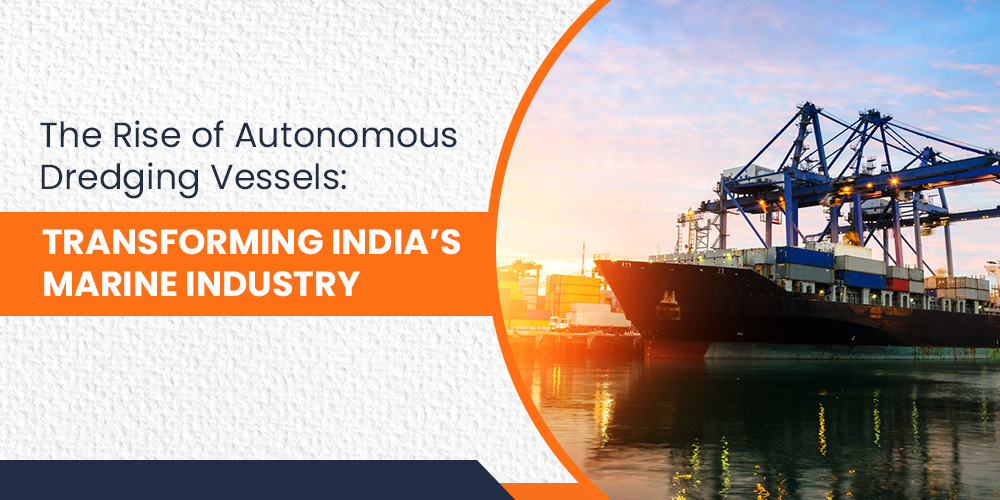Blogs

The Rise of Autonomous Dredging Vessels: Transforming India’s Marine Industry
The Rise of Autonomous Dredging Vessels
The marine engineering sector is witnessing a technological revolution, and at the forefront of this change is the rise of autonomous dredging vessels. As one of India’s leading dredging and shipbuilding companies, Rock & Reef has always prioritized innovation, quality, and sustainability in its operations. The integration of autonomous technology into dredging is not just a global trend-it is a transformative force shaping the future of India’s maritime infrastructure.
What Are Autonomous Dredging Vessels?
Autonomous dredging vessels are ships equipped with advanced sensors, artificial intelligence, and automated control systems that allow them to perform dredging operations with minimal human intervention. These vessels can navigate, monitor, and execute dredging tasks efficiently, relying on real-time data and sophisticated algorithms to optimize performance.
Drivers Behind the Shift to Autonomy
Several factors are fueling the adoption of autonomous dredging technology:
- Efficiency: Automated systems can operate around the clock, reducing downtime and increasing project speed.
- Precision: Advanced sensors and AI enable vessels to execute dredging with greater accuracy, minimizing over-dredging and reducing waste.
- Safety: By reducing the need for human presence in hazardous marine environments, autonomous vessels lower the risk of accidents.
- Cost Savings: Automation can cut labor costs and maintenance expenses, making large-scale projects more economically viable.
Technological Advancements Enabling Autonomy
Rock & Reef’s commitment to technological advancement is reflected in its investment in the latest dredging equipment and shipbuilding technologies. Key innovations driving autonomous dredging include:
- Real-Time Data Analytics: Sensors collect and analyze data on seabed conditions, sediment types, and vessel performance, enabling dynamic decision-making.
- GPS and Navigation Systems: High-precision GPS ensures accurate positioning and movement, essential for effective dredging.
- Remote Monitoring: Operators can oversee multiple vessels from a central control room, adjusting operations as needed.
- Machine Learning: AI algorithms learn from past projects, continuously improving efficiency and outcomes.
Benefits for India’s Marine Infrastructure
India’s coastline is rapidly developing, with new ports, harbors, and shipping channels emerging to support economic growth. Autonomous dredging vessels offer several advantages for these projects:
- Faster Project Completion: Automation accelerates dredging timelines, helping meet tight project deadlines.
- Environmental Stewardship: Precision dredging reduces ecological impact, aligning with Rock & Reef’s commitment to sustainable practices and marine conservation.
- Quality and Reliability: Consistent, data-driven operations set new benchmarks for project quality and reliability, two pillars of Rock & Reef’s reputation.
Rock & Reef: Leading the Way in Innovation
With over 25 years of experience and more than 100 successful dredging works, Rock & Reef stands out as a pioneer in adopting innovative solutions for marine engineering. Our approach combines:
- Unparalleled Execution: Every project is completed with a focus on reliability and professionalism.
- Client-Centric Solutions: We tailor our services to meet the unique needs of each client, leveraging the latest technology to deliver results.
- Sustainability: Our projects are designed to balance economic development with environmental conservation, minimizing our ecological footprint.
Challenges and Considerations
While the benefits are significant, the transition to autonomous dredging is not without challenges:
- Initial Investment: Advanced technology requires substantial upfront investment in equipment and training.
- Regulatory Hurdles: Maritime regulations must evolve to accommodate unmanned vessels and ensure safety.
- Skill Development: The workforce must adapt, with new roles focused on data analysis, remote operations, and system maintenance.
Rock & Reef addresses these challenges through continuous learning, strategic partnerships, and a commitment to staying ahead of industry trends.
Case Study: Autonomous Dredging in Action
Imagine a major port expansion project on India’s west coast. Traditionally, such a project would require a large crew, manual monitoring, and frequent adjustments. With autonomous dredging vessels, Rock & Reef can deploy a fleet of smart ships, each equipped with real-time sensors and AI-driven controls. Operations are monitored from a central hub, where experts analyze data and optimize performance remotely. The result: faster completion, reduced environmental impact, and a safer work environment.
The Future of Dredging in India
The adoption of autonomous dredging vessels marks a new era for India’s marine infrastructure. As demand for efficient, sustainable, and high-quality dredging grows, companies like Rock & Reef are leading the way by embracing innovation and setting new industry standards.
By integrating cutting-edge technology with decades of expertise, Rock & Reef ensures that every project not only meets client expectations but also contributes to the long-term health of India’s coastal ecosystems.
Ready to transform your next marine project with the latest in dredging technology?
Contact Rock & Reef Today to learn how our innovative solutions can deliver exceptional results for your business.
For more information on our services and expertise, visit Rock & Reef Dredging.

